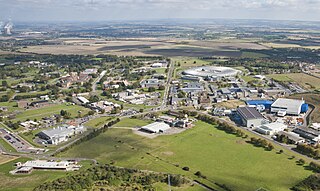Related Research Articles

The Council for the Central Laboratory of the Research Councils (CCLRC) was a UK government body that carried out civil research in science and engineering.

The Particle Physics and Astronomy Research Council (PPARC) was one of a number of research councils in the United Kingdom. It directed, coordinated and funded research in particle physics and astronomy for the people of the UK. Its head office was at Polaris House in Swindon, Wiltshire, but it also operated three scientific sites: the UK Astronomy Technology Centre in Edinburgh, the Isaac Newton Group of Telescopes (ING) in La Palma and the Joint Astronomy Centre (JAC) in Hawaii. It published the Frontiers magazine three times a year, containing news and highlights of the research and outreach programmes it supports.

The Isaac Newton Institute for Mathematical Sciences is an international research institute for mathematics and its many applications at the University of Cambridge. It is named after one of the university's most illustrious figures, the mathematician and natural philosopher Sir Isaac Newton and occupies one of the buildings in the Cambridge Centre for Mathematical Sciences.
Biotechnology and Biological Sciences Research Council (BBSRC), part of UK Research and Innovation, is a non-departmental public body (NDPB), and is the largest UK public funder of non-medical bioscience. It predominantly funds scientific research institutes and university research departments in the UK.

The Rutherford Appleton Laboratory (RAL) is one of the national scientific research laboratories in the UK operated by the Science and Technology Facilities Council (STFC). It began as the Rutherford High Energy Laboratory, merged with the Atlas Computer Laboratory in 1975 to create the Rutherford Lab; then in 1979 with the Appleton Laboratory to form the current laboratory.
The Engineering and Physical Sciences Research Council (EPSRC) is a British Research Council that provides government funding for grants to undertake research and postgraduate degrees in engineering and the physical sciences, mainly to universities in the United Kingdom. EPSRC research areas include mathematics, physics, chemistry, artificial intelligence and computer science, but exclude particle physics, nuclear physics, space science and astronomy. Since 2018 it has been part of UK Research and Innovation, which is funded through the Department for Business, Energy and Industrial Strategy.

The Royal Observatory, Edinburgh (ROE) is an astronomical institution located on Blackford Hill in Edinburgh. The site is owned by the Science and Technology Facilities Council (STFC). The ROE comprises the UK Astronomy Technology Centre (UK ATC) of STFC, the Institute for Astronomy of the School of Physics and Astronomy of the University of Edinburgh, and the ROE Visitor Centre.
George Ernest Kalmus, CBE, FRS is a noted British particle physicist.

Research Councils UK, sometimes known as RCUK, was a non-departmental public body which coordinated science policy in the United Kingdom from 2002 to 2018. It was an umbrella organisation that coordinated the seven separate research councils that were responsible for funding and coordinating academic research for the arts, humanities, science and engineering. In 2018 Research Councils transitioned into UK Research and Innovation (UKRI).

The Department of Physics and Astronomy at the University of Manchester is one of the largest and most active physics departments in the UK, taking around 250 new undergraduates and 50 postgraduates each year, and employing more than 80 members of academic staff and over 100 research fellows and associates. The department is based on two sites: the Schuster Laboratory on Brunswick Street and the Jodrell Bank Centre for Astrophysics in Cheshire, international headquarters of the Square Kilometre Array (SKA).
STFC can stand for:

Daresbury Laboratory is a scientific research laboratory based at Sci-Tech Daresbury campus near Daresbury in Halton, Cheshire, England. The laboratory began operations in 1962 and was officially opened on 16 June 1967 as the Daresbury Nuclear Physics Laboratory by the then Prime Minister of United Kingdom, Harold Wilson. It is operated by the Science and Technology Facilities Council, part of UK Research and Innovation. As of 2018, it employs around 300 staff, with Professor Susan Smith appointed as director in 2012.
The Science and Technology Facilities Council (STFC) is a United Kingdom government agency that carries out research in science and engineering, and funds UK research in areas including particle physics, nuclear physics, space science and astronomy.

Keith Mason was, until 1 November 2011, the Chief Executive of the Science and Technology Facilities Council (STFC) of the United Kingdom. He assumed the post on 1 April 2007 after the merger of the Council for the Central Laboratory of the Research Councils (CCLRC) and the Particle Physics and Astronomy Research Council (PPARC), having previously been chief executive of PPARC.
Christine Tullis Hunter Davies is a professor of Physics at the University of Glasgow.

Tara Georgina Shears is a Professor of Physics at the University of Liverpool.
Carole Mundell is Professor of Extragalactic Astronomy at the University of Bath. She is an observational astrophysicist who researches cosmic black holes and gamma ray bursts.
Research England is a part of United Kingdom Research and Innovation (UKRI) that oversees the functions of UKRI in relation to university research and knowledge transfer in England. This includes:
Philippa K. Browning is a Professor of Astrophysics in the Jodrell Bank Centre for Astrophysics at the University of Manchester. She specialises in the mathematical modelling of fusion plasmas.
Andrew Dawson Taylor is director of the Science and Technology Facilities Council National Laboratories – Rutherford Appleton Laboratory, Daresbury Laboratory, and the UK Astronomy Technology Centre in Edinburgh.
References
- ↑ Anon (2019). "Our beginnings". epsrc.ukri.org. EPSRC. Archived from the original on 2019-11-11.
- ↑ "Science And Engineering Research Council (SERC)". archiveshub.jisc.ac.uk. Newcastle.
- ↑ Walgate, Robert (1983). "UK energy research: Powers link up with SERC". Nature. 304 (5922): 106. Bibcode:1983Natur.304..106W. doi: 10.1038/304106a0 . ISSN 0028-0836.
- ↑ Anon (1993). "Realising our potential: A strategy for Science, Engineering and Technology". epsrc.ukri.org. Archived from the original on 2019-11-12.
- ↑ Dickson, David (1993). "William Waldegrave wants to carve up SERC and create stronger political links". Nature. 363 (6427): 289. doi: 10.1038/363289a0 . ISSN 0028-0836.